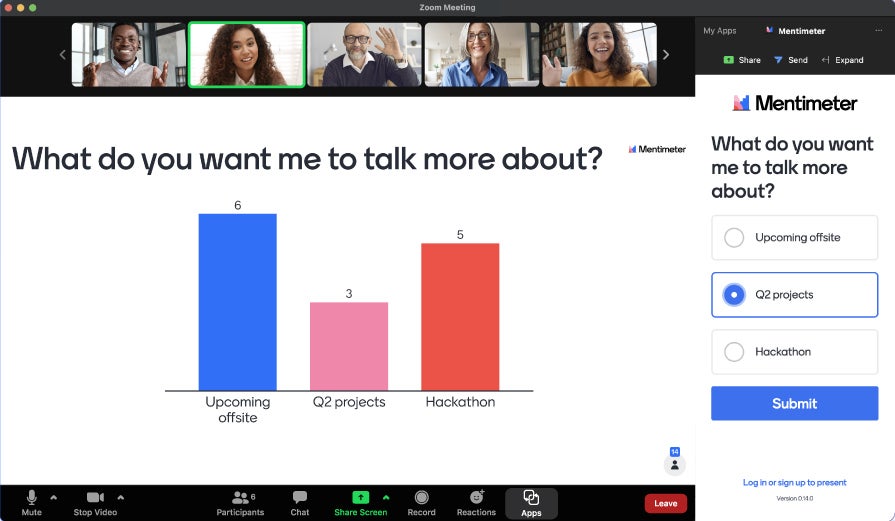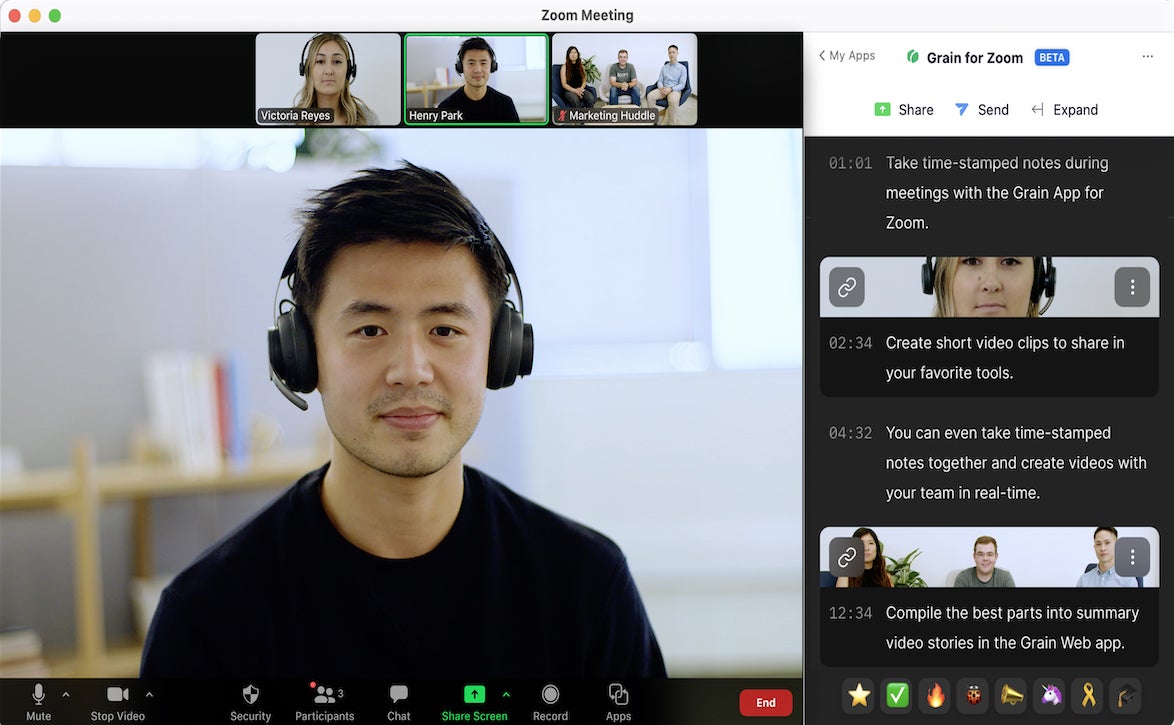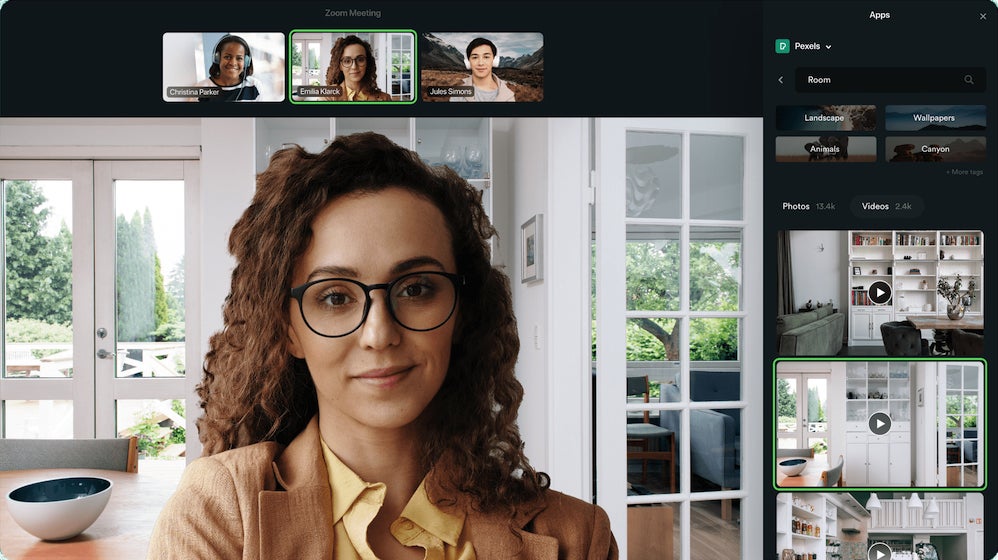
4 big ways to put Zoom apps to work
With many companies using Zoom as a primary way to connect remote workers over the past 18+ months, company meetings, strategy sessions, project discussions, and more moved to the videoconferencing platform — and so did a large chunk of business data and content. Organizations that have invested lots of money in other collaboration tools suddenly found themselves concerned with their ability to monitor, preserve, and access the data in Zoom for workflow, security, troubleshooting, or marketing purposes.
While Zoom has long offered integrations with hundreds of different tools that connect the services in various ways, such as by allowing you to launch a Zoom meeting from within another app, the company recently launched Zoom Apps, which bring certain aspects of other apps and services into Zoom meetings. It’s a bit confusing, especially when you visit the Zoom App Marketplace and find “Zoom Apps” listed as a category alongside more typical categories such as Analytics, Collaboration, and Productivity.
We set out to find the most useful types of apps in the Zoom App Marketplace for enhancing and extending Zoom. Rather than worry about whether something is a “Zoom App” or a Zoom integration with another app, we chose to highlight the different tools that can help create a better video meeting experience or allow companies to track, analyze, and secure data from Zoom video calls and chat sessions.
We created our own categories below based on our insights, but there is some overlap among them — for instance, some collaboration apps include recording and transcription elements. The following are not necessarily endorsements of specific apps, but rather examples that highlight the different types of apps available within a few key business categories. There are hundreds of additional apps that you can find via the App Marketplace.
When researching apps, keep in mind that many of them require specific user roles (such as account admin) and account types in Zoom, while others allow regular users to install them. Within each app description is a list of installation requirements (including which version of Zoom is required), app permissions and scope, and support resources from each developer. Before you install any app, make sure the permissions it requests don’t violate your company’s privacy policies.
The developer resources for each app include a documentation page with instructions for installing and using the app. In most cases, you’ll be required to set up an account (or sign in to an existing account) with the service you’re connecting to Zoom.
Productivity and collaboration
Many different collaboration apps allow hooks into Zoom, letting you launch a Zoom call or create a Zoom link from within that application instead of having to switch over to Zoom. Apps that do this include Google Workspace, Gmail, Microsoft Teams, LinkedIn Video Meetings, Zendesk by Zoom, Spark, and more. The Slack app lets you start Zoom meetings right in a Slack channel or group message, and share the meeting recording there afterward. Chances are good that if you are using a collaboration app, there’s a Zoom integration that goes along with it.
Many productivity and collaboration apps tie in with Zoom more deeply, and others improve the meeting experience itself, as demonstrated by these examples:
- Box app for Zoom: Access, browse, preview, and share files stored in Box cloud storage from within Zoom; present a Box file to others in a Zoom meeting; and upload files to Box from within Zoom.
- Actionable Meetings by Wrike: Connect Zoom meetings to tasks and projects in the Wrike work management tool. You can capture action items and assign tasks during or after Zoom meetings; attach files, add comments, and set due dates; send follow-ups to meeting attendees; and automatically pull recordings and transcripts into Wrike. (See also: Asana App for Zoom, Coda, Dropbox Spaces, monday.com, Notejoy)
- Mentimeter: Engage participants with live polls, quizzes, word clouds, open-ended questions, and Q&As to capture real-time input in a Zoom meeting. While this app is geared toward students, it can also be used with regular employee meetings. (See also: Dot Collector, Polly, SurveyMonkey)
 Mentimeter
Mentimeter- Lucidspark Whiteboard: Create, share, and work together on Lucidspark whiteboards with meeting attendees to increase engagement and enhance team collaboration from within Zoom. Features include shape libraries, GIFs, images, and freehand drawing, as well as timers to keep the meeting on track. (See also: Miro, Mural)
- Zapier: Use Zapier to automate workflows between Zoom and any of more than 1,500 apps and services with simple if/then commands. For example, you can set up Zapier so that creating a new meeting in Zoom automatically creates a new record or updates an existing record in Airtable. (See also: Automate:io, IFTTT)
Recording and transcription
With more meetings happening over video than in person these days, it’s more important than ever to create a permanent record of what was said. While Zoom’s business and enterprise plans include basic meeting recording and transcription capabilities, advanced tools can be integrated into Zoom. Examples include:
- Colibri: This app records Zoom meetings and includes live transcription with speaker identification. You can highlight key points and share them as meeting notes. Transcripts and highlights from previous meetings are accessible and searchable from within Zoom. (See also: Otter.ai Live Notes for Zoom, RaeNotes, Trint, Airgram, Rev, Verbit Live Transcription, Fireflies.ai)
- Grain for Zoom: The Grain app lets you transcribe, highlight, and share the most important moments from a Zoom call. You can create highlight clips, compress long meetings into three-minute summaries, or remix the highlights into stories, any of which can be automatically shared with other tools like Slack, Notion, and Asana. The system also lets you manage and search a recorded meeting library, and you can import older Zoom recordings to generate transcripts and highlights. (See also: Dovetail)
 Grain Intelligence
Grain Intelligence- Laxis: In addition to real-time meeting transcriptions, you can create personalized meeting templates that capture the exact information you need, receive auto-generated key quotes, and identify key insights from conversations. The AI-driven app is geared toward product managers, researchers, analysts, consultants, journalists, HR pros, and anyone doing research interviews.
Business analytics
These apps help teams collaborate around data and provide trends to spur data-driven decisions. Zoom apps in this category give organizations insights on how Zoom is being used across the enterprise, and can connect with other analytics sites and data. Examples include:
- Domo: Provides dashboards and visualizations to help organizations understand and assess their company’s current Zoom activity, such as how many meetings are taking place, how long meetings last, and how many people are participating. Detailed metrics show collaboration patterns and service usage to help companies maximize their Zoom investment. (See also: Peoplelogic.ai, Worklytics Analytics Connector, Conferencing Analytics)
 Domo
Domo- Bver: Billing itself as the Grammarly for voice, the app joins your Zoom calls and analyzes speech patterns among participants. It then provides users with alerts that help them be more aware of their speaking style, helping them avoid negative behaviors and adopt the right tone needed for better conversations. (See also: Voxpopme, Lex Analytics, Cassiopeia)
- CLIPr: Video analysis and management platform. After Zoom users upload meeting recordings to the app, the AI analyzes the video and identifies key moments and speakers, creating a virtual library of personalized video recaps.
- OnePgr Deal Room: Helps improve the sales process by delivering visibility into customer meeting interactions through sentiment analysis. (See also: Shadow All-in-One Analytics, People.ai, Deepagent, Woopra)
- Teamplify: Aimed at development teams, Teamplify lets managers see employees’ activity in Jira, Trello, Slack, GitHub, Bitbucket, GitLab, and Zoom all in one place. The Zoom app lets you see the meetings in which members participated, including their duration and other participants. A collaborators’ report shows whom each member communicated with the most.
IT administration, compliance, and security
Several different security apps can help track Zoom calls in order to provide transparency into data and systems, especially for industries that require regulatory compliance and governance. In addition, a number of Zoom integrations help IT with user support, licensing, and other administrative duties.
- Obsidian Security: Lets security teams monitor Zoom calls to protect against inappropriate recording, oversharing, and suspicious Zoom usage. The app can alert teams to threats such as meetings recorded in sensitive environments, unexpected participants on a regular Zoom call, meetings created without passwords, and more. (See also: ZeroFOX, SafeGuard Cyber, Vectrix, Trelica)
- Hyperproof: By integrating Zoom with this compliance operations platform, you can start a Zoom meeting from within Hyperproof, and the system will import the recording as proof for any audits. (See also: Onna, Cognitive View)
- Blissfully: The app lets administrators track which employees and executives have Zoom licenses and create workflows to manage license ownership.
- Aternity: This user experience monitoring app is deployed on employee devices, tracking application and device performance to help IT troubleshoot problems. IT staff can gain visibility into the quality of Zoom meetings and understand the possible causes of Zoom meeting issues, such as poor Wi-Fi or a high machine load. (See also: Nectar 10)
 Aternity
Aternity- PowerSuite: Unify Square’s PowerSuite is a collaboration and communication management platform that supports Microsoft Teams and Slack as well as Zoom. IT leaders can manage administration duties through a single dashboard, rather than separate administration consoles for each app. Includes adoption and usage analytics, troubleshooting guidance, policy management, and more.
Other apps to consider
Zoom also features apps geared to specific work functions, such as sales and CRM tools that monitor and record calls and integrate with apps such as Salesforce; event management apps to monitor, record, and analyze webinars produced via Zoom; finance apps that allow financial firms to record, monitor, and store earnings calls and investor meetings, or even integrate payment for video services; customer service apps that help companies manage support tickets and customer interactions that occur over Zoom; healthcare apps for medical professionals to conduct telehealth calls that can be monitored and recorded; and education apps that coordinate and monitor school-related Zoom activity for remote learning.
Finally, it might be worth exploring a few games and other light apps that could provide an icebreaker before or after a meeting or help break up the monotony of “yet another Zoom call.” For example, the Pexels – Virtual Backgrounds app integrates with the Pexels royalty-free image site, allowing you to choose from more than 3 million photos to use as virtual backgrounds in Zoom calls. There are professional workspaces, stunning landscapes, quirky art pieces, famous landmarks, and more, letting you select just the right background for any meeting.
 Pexels
Pexels